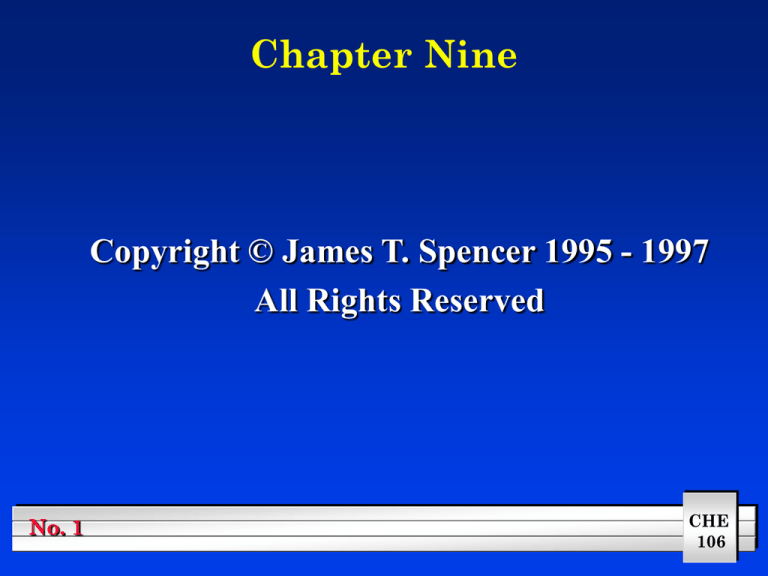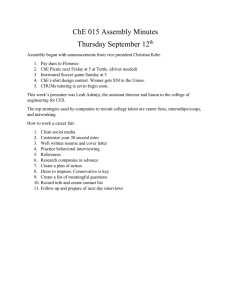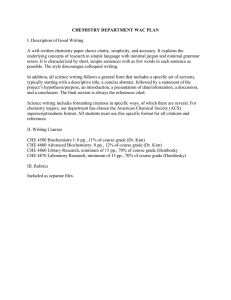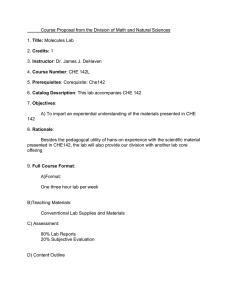
Chapter Nine
Copyright © James T. Spencer 1995 - 1997
All Rights Reserved
No. 1
CHE
106
Molecular Shapes and Bonding
• Molecular Shape guides chemical reactivity,
especially biological.
• Why is water bent while CO2 is linear?
• Why is ClF3 T-shaped while NF3 is pyramidal?
• Why is CF4 tetrahedral while XeF4 is planar?
N
C
Cl
O
No. 2
CHE
106
Molecular Geometry
Definitions:
» Bond Distance - the distance (usually in
either Å or pm) between two bonded atoms
» Bond Angles - the angle formed between
three bonded atoms
A
A
No. 3
bond
distance
bond A
angle
CHE
106
Valence-Shell Electron Pair
Repulsion Theory (VSEPR)
Electrons repel one another (same charge).
Arrange electron pairs around atoms in a molecule
so as to maximize the distance between them
(placing them as far apart as possible while still
attached to the central atom). Minimize repulsions!
Use AXE Notation to help keep track:
A = central atom
X = number of bond pairs of electrons
E = number of “lone” (unshared) pairs of electrons
No. 4
CHE
106
Valence-Shell Electron Pair
Repulsion Theory (VSEPR)
1st
Approximation, assume bond and
lone electron pairs are equivalent.
Derive “Parent” Structures for
various numbers of electron pairs
around the central atom. (2 - 6 pairs).
Consider “balloon” model.
At the end, differentiate between
bond and lone electron pairs by
placing non-central atoms
No. 5
CHE
106
Valence-Shell Electron Pair
Repulsion Theory (VSEPR)
2 Electron Pairs - AX2E0
No. 6
CHE
106
Valence-Shell Electron Pair
Repulsion Theory (VSEPR)
3 Electron Pairs
AX3E0
No. 7
CHE
106
Valence-Shell
Electron Pair
Repulsion Theory
(VSEPR)
4 Electron Pairs
AX4E0
No. 8
CHE
106
Valence-Shell Electron Pair
Repulsion Theory (VSEPR)
5 Electron Pairs
AX5E0
No. 9
CHE
106
Valence-Shell Electron Pair
Repulsion Theory (VSEPR)
5 Electron Pairs
AX5E0
No. 10
CHE
106
Valence-Shell
Electron Pair
Repulsion Theory
(VSEPR)
6 Electron Pairs
AX6E0
No. 11
CHE
106
VSEPR
Arrange electron pairs so as to maximize the
distance between them.
AXE
Shape
Name
AX1E0
Linear
AX2E0
Linear
AX3E0
Trigonal Planar
AX4E0
Tetrahedron
No. 12
= electron pair
CHE
106
VSEPR
Arrange electron pairs so as to maximize the
distance between them.
AXE
Shape
Name
AX1E0
Linear
AX2E0
Linear
AX3E0
Trigonal Planar
AX4E0
Tetrahedron
No. 13
= electron pair
CHE
106
VSEPR
Arrange electron pairs so as to maximize the
distance between them.
AXE
Shape
Name
AX1E0
Linear
AX2E0
Linear
AX3E0
Trigonal Planar
AX4E0
Tetrahedron
No. 14
= electron pair
CHE
106
VSEPR
Arrange electron pairs so as to maximize the
distance between them.
AXE
Shape
Name
AX1E0
Linear
AX2E0
Linear
AX3E0
Trigonal Planar
AX4E0
Tetrahedron
No. 15
= electron pair
CHE
106
VSEPR
Arrange electron pairs so as to maximize the
distance between them.
AXE
Shape
Name
AX5E0
Trigonal
bipyramid
AX6E0
Octahedron
No. 16
= electron pair
CHE
106
VSEPR
Arrange electron pairs so as to maximize the
distance between them.
AXE
Shape
Name
AX5E0
Trigonal
bipyramid
AX6E0
Octahedron
No. 17
= electron pair
CHE
106
Closer Look at Structures
Linear
Linear
180°
180°
“flat”
molecule
120°
Trigonal Planar
No. 18
“tripod”
molecule
109.5°
Tetrahedral
CHE
106
Closer Look at Structures
Axial Positions
Equatorial Positions
180°
120°
90°
Trigonal Bipyramid
180°
90°
Octahedron
No. 19
CHE
106
VSEPR
Summary:
–The best electron pair arrangement
minimizes electron-electron repulsions.
–Both bonding electron pairs and
unshared (non-bonding) electron pairs
are arranged to minimize repulsions.
–Use AXE notation to determine actual
molecular geometries.
No. 20
CHE
106
Valence-Shell Electron Pair
Repulsion Theory (VSEPR)
Determine Lewis structure
Determine number of electron pairs around
the central atom
Determine AXE notation
Assign structure based upon parent
structure - minimizing repulsions
Determine any distortions of bond angles
No. 21
CHE
106
2 Pairs
VSEPR and AXE
A = central atom; X = number of bond pairs of electrons;
E = number of “lone” (unshared) pairs of electrons
AXE
Shape
Name
AX1E0
Linear
AX2E0
Linear
AX1E1
No. 22
:
Linear
CHE
106
2 Pairs
VSEPR and AXE
A = central atom; X = number of bond pairs of electrons;
E = number of “lone” (unshared) pairs of electrons
AXE
Shape
Name
AX1E0
Linear
AX2E0
Linear
AX1E1
No. 23
:
Linear
CHE
106
3 Pairs
VSEPR and AXE
A = central atom; X = number of bond pairs of electrons;
E = number of “lone” (unshared) pairs of electrons
AXE
Shape
Name
AX3E0
Trigonal Planar
AX2E1
Bent
AX1E2
Linear
No. 24
Trigonal Planar Angle = 120°
CHE
106
3 Pairs
VSEPR and AXE
A = central atom; X = number of bond pairs of electrons;
E = number of “lone” (unshared) pairs of electrons
AXE
Shape
Name
AX3E0
Trigonal Planar
AX2E1
Bent
AX1E2
Linear
No. 25
Trigonal Planar Angle = 120°
CHE
106
3 Pairs
VSEPR and AXE
A = central atom; X = number of bond pairs of electrons;
E = number of “lone” (unshared) pairs of electrons
AXE
Shape
Name
AX3E0
Trigonal Planar
AX2E1
Bent
AX1E2
Linear
No. 26
Trigonal Planar Angle = 120°
CHE
106
Nonbonding Electrons and
Multiple Bonds
Non-bonding electron pairs exert greater
repulsive forces on adjacent electron pairs and,
therefore, compress the angles between the bond
pairs.
Electrons in multiple bonds exert greater
repulsive forces on adjacent electron pairs and,
therefore, compress the angles between the bond
pairs (similar to nonbonding electrons).
109.5°
107°
No. 27
104.5°
CHE
106
4 Pairs
VSEPR and AXE
A = central atom; X = number of bond pairs of electrons;
E = number of “lone” (unshared) pairs of electrons
AXE
Shape
Name
AX4E0
Tetrahedron
AX3E1
Trigonal Pyramidal
AX2E2
Bent
No. 28
Tetrahedral Angle = 109.5°
CHE
106
4 Pairs
VSEPR and AXE
A = central atom; X = number of bond pairs of electrons;
E = number of “lone” (unshared) pairs of electrons
AXE
Shape
Name
AX4E0
Tetrahedron
AX3E1
Trigonal Pyramidal
AX2E2
Bent
No. 29
Tetrahedral Angle = 109.5°
CHE
106
4 Pairs
VSEPR and AXE
A = central atom; X = number of bond pairs of electrons;
E = number of “lone” (unshared) pairs of electrons
AXE
Shape
Name
AX4E0
Tetrahedron
AX3E1
Trigonal Pyramidal
AX2E2
Bent
No. 30
Tetrahedral Angle = 109.5°
CHE
106
5 Pairs
VSEPR and AXE
A = central atom; X = number of bond pairs of electrons;
E = number of “lone” (unshared) pairs of electrons
AXE
Shape
Name
AX5E0
Trigonal Bipyramid
AX4E1
See-Saw
AX3E2
T-Shaped
AX2E3
Linear
No. 31
Angles = 120° and 90°
CHE
106
5 Pairs
VSEPR and AXE
A = central atom; X = number of bond pairs of electrons;
E = number of “lone” (unshared) pairs of electrons
AXE
Shape
Name
AX5E0
Trigonal Bipyramid
AX4E1
See-Saw
AX3E2
T-Shaped
AX2E3
Linear
No. 32
Angles = 120° and 90°
CHE
106
5 Pairs
VSEPR and AXE
A = central atom; X = number of bond pairs of electrons;
E = number of “lone” (unshared) pairs of electrons
AXE
Shape
Name
AX5E0
Trigonal Bipyramid
AX4E1
See-Saw
AX3E2
T-Shaped
AX2E3
Linear
No. 33
Angles = 120° and 90°
CHE
106
5 Pairs
VSEPR and AXE
A = central atom; X = number of bond pairs of electrons;
E = number of “lone” (unshared) pairs of electrons
AXE
Shape
Name
AX5E0
Trigonal Bipyramid
AX4E1
See-Saw
AX3E2
T-Shaped
AX2E3
Linear
No. 34
Angles = 120° and 90°
CHE
106
6 Pairs
VSEPR and AXE
A = central atom; X = number of bond pairs of electrons;
E = number of “lone” (unshared) pairs of electrons
AXE
Shape
Name
AX6E0
Octahedron
AX5E1
Square Pyramid
AX4E2
Square Planar
AX3E3
T-Shaped
No. 35
Angles = 180° and 90°
CHE
106
6 Pairs
VSEPR and AXE
A = central atom; X = number of bond pairs of electrons;
E = number of “lone” (unshared) pairs of electrons
AXE
Shape
Name
AX6E0
Octahedron
AX5E1
Square Pyramid
AX4E2
Square Planar
AX3E3
T-Shaped
No. 36
Angles = 180° and 90°
CHE
106
6 Pairs
VSEPR and AXE
A = central atom; X = number of bond pairs of electrons;
E = number of “lone” (unshared) pairs of electrons
AXE
Shape
Name
AX6E0
Octahedron
AX5E1
Square Pyramid
AX4E2
Square Planar
AX3E3
T-Shaped
No. 37
Angles = 180° and 90°
CHE
106
6 Pairs
VSEPR and AXE
A = central atom; X = number of bond pairs of electrons;
E = number of “lone” (unshared) pairs of electrons
AXE
Shape
Name
AX6E0
Octahedron
AX5E1
Square Pyramid
AX4E2
Square Planar
AX3E3
T-Shaped
No. 38
Angles = 180° and 90°
CHE
106
VSEPR;
BF4-2 vs.
BeF4-2
Lewis Structure:
Be
1x2 =2
F
4 x 7 = 28
charge
=2
TOTAL
= 32 (16 prs)
__
__ |F
__| __
AX
E
|F
|
Be
|
F|
4
0
__ __ __
|F
__|
Tetrahedron
No. 39
Parent
XeF4
Lewis Structure
bond and lone prs
AXE
det. parent
subst. lone prs
det. distortions
name struct.
F
Be
F
F
F
Molecule
CHE
106
VSEPR
XeF4
Lewis Structure:
Xe
1x8 =8
F
4 x 7 = 28
TOTAL
= 36 (18 prs)
__ __
__|F||F|__
|F
F|
__| Xe | __
AX4E2
Square Planar
No. 40
Lewis Structure
bond and lone prs
AXE
det. parent
subst. lone prs
det. distortions
name struct.
F
F
Xe
F
Parent
F
Molecule
CHE
106
VSEPR
I3-1
Lewis Structure:
I 3x7
= 21
charge
= 1
TOTAL
= 22 (11 prs)
__ __ __
|__
I | I | I|
__
Lewis Structure
bond and lone prs
AXE
det. parent
subst. lone prs
det. distortions
name struct.
I
AX2E3
Xe
I
I
Linear
No. 41
Parent
Molecule
CHE
106
VSEPR
SeF4
Lewis Structure:
Se 1 x 6
=6
F 4x7
= 28
TOTAL
= 34 (17 prs)
__ __
__|F||F|__
|F
| F|
__| Se
__ __
Lewis Structure
bond and lone prs
AXE
det. parent
subst. lone prs
det. distortions
name struct.
F
AX4E1
Xe
Se
F
F
See-Saw
No. 42
Parent
F
Molecule
CHE
106
VSEPR “Hints”
For multiple bonds, count only one bonding pair
of electrons regardless of the bond order for
determining the AXE notation.
X-A
AX1
X=A
AX1
X A
AX1
For transition metals, disregard d electrons for
valence counting and AXE Notation.
Learn only the six parent “shapes” and figure out
others from these.
No. 43
CHE
106
VSEPR Practice
Try these using VSEPR:
» OF2
» ClO2 -1
» BF3
» PBr3
» TeCl4
» BrO4-1
» SnCl4
» SF6
» XeOF4
No. 44
CHE
106
Polarity of Molecules
H
Bond
S
B
P
P
P
Li
N
O
No. 45
EN = 4.0 - 2.1 = 1.9
Polar Covalent Bond
Polarity:
EN
S non-polar
0
1.0
Cl polar covalent
1.9
F polar covalent
0.9
Cl polar covalent
1.4
O polar covalent
3.0
F ionic
1.0
F polar covalent
0.0
O non-polar
F
Element
F
O
N
C
B
Li
P
Cl
Br
EN
4.0
3.5
3.0
2.5
2.0
1.0
2.1
3.0
2.8
CHE
106
Polarity of Molecules
Molecules can be polar or non-polar.
Polar molecules are called dipoles since they have
positive and negative ends.
Dipoles align in electric field gradient and with
one another.
+ + + + + + + -
(-)
(+)
H
No. 46
F
CHE
106
Polarity of Molecules
Degree of molecular polarity is given by the
DIPOLE MOMENT ( given in Debyes; 1 D = 3.3 x
10-30 coulomb meters) of the molecule.
=Qr
(Q = charges and r = separation)
Determining Molecular Dipole Moments (polarity);
– requires polar bonds
– depends upon the geometry
No. 47
CHE
106
Polarity and Geometry
O
H
No. 48
C
O
O
Linear (AX2E0)
Dipole moment = 0
H
Bent (AX2E2)
Dipole mom. = 1.84 D
CHE
106
Polarity and Geometry
..
F
N
B
F
F
F
F
Trig. Planar
(AX3E0)
=0
No. 49
F
Trig. Pyramid
(AX3E1)
= 1.0
CHE
106
Covalent Bonding
Closer
look at quantum mechanics of
covalent bonding.
Orbital Overlap
Wave functions = orbitals
No. 50
CHE
106
Orbital Overlap
• Wave function (wave
properties)
• Can “constructively” and
“destructively add waves (just
like ripples on a pond).
1s orbital
2
0 radius
H atom
1
Move together to
overlap waves
0 radius
No. 51
1s orbitals
2
H atom
2
0 radius
CHE
106
Covalent Bonding
Destructive
Addition of
Waves
(out of phase)
Constructive
Addition of
Waves
(in phase)
No. 52
2
H atom
2
H atom
1
0
radius
0
2
H atom
2
H atom
1
0
radius
0
CHE
106
Covalent Bonding
s orbital - in-phase addition (bonding)
+
s orbital - out-of-phase addition (antibonding)
+
No. 53
CHE
106
Orbital Overlap
0
E
n
e
r
g
y
Distance between atoms
No. 54
CHE
106
Hybrid Orbitals
Orbital overlap can become complicated for
polyatomic molecules.
Simpler conceptual model developed -
Hybridization (valence bond theory).
For central atoms, how can sufficient orbitals be
available for electron sharing if they are already
occupied in the ground state?
– Use conceptual process of electron promotion
and forming hybrid orbitals.
2s
2p
2s
2p
CaF2
No. 55
CHE
106
Hybridization
CaF2
E
n
e
r
g
y
2s
Promotion
2s
2p
Hybridization
2p
sp hybrids
No. 56
2p
CHE
106
sp Hybrid Orbitals
sp hybrid orbitals formed from the combination of
one s and one p orbital (linear arrangement).
+
+
linear
No. 57
CHE
106
Hybridization
BF3
E
n
e
r
g
y
2s
Promotion
2s
2p
Hybridization
2p
sp2 hybrids
No. 58
2p
CHE
106
sp2 Hybridization
E
n
e
r
g
y
2s
Promotion
2s
2p
“Unused”’ p atomic
orbital on carbon
Hybridization
2p
sp2 hybrids
2p
3 equivalent sp2
hybrid orbitals
No. 59
CHE
106
sp2 Hybrid Orbitals
sp2 hybrid orbitals formed from the combination
of one s and one p orbital (linear arrangement).
+
+
+
No. 60
trigonal planar
CHE
106
sp3 Hybridization
CF4
E
n
e
r
g
y
2s
Promotion
2s
2p
Hybridization
2p
sp3 hybrids
No. 61
CHE
106
sp3 Hybrid Orbitals
sp2 hybrid orbitals formed from the combination
of one s and one p orbital (linear arrangement).
+
+
+
+
tetrahedral
No. 62
CHE
106
sp3d Hybridization
E
n
e
r
g
y
s
s
p
d
Promotion
p
Hybridization
d
d
sp3d hybrids
No. 63
CHE
106
sp3d2 Hybridization
E
n
e
r
g
y
s
s
p
d
Promotion
p
Hybridization
d
d
sp3d2 hybrids
No. 64
CHE
106
Hybrid Orbitals
Hybridization:
– Draw Lewis Structure
– Determine VSEPR (AXE) model geometry
– Specify hybrid orbitals needed to accommodate
the electron pairs to fit the geometry from
VSEPR
–Shapes:
» sp = linear
» sp3 = tetrahedral
» sp3d2 = octahedron
No. 65
sp2 = trigonal planar
sp3d = trig. bipyramid
CHE
106
Hybrid Orbitals
sp3
sp = linear
No. 66
sp3d2
sp3d
sp2 = trigonal planar
CHE
106
Hybrid Orbitals and Molecules
Overlap hybrid orbitals to make bonds
No. 67
F
F
B
B
CHE
106
Multiple Bonds
Bond Types
– Electron density along internuclear axis SIGMA BOND ().
– Electron density above and below internuclear
axis - PI BOND ().
1 (sigma)
0 (pi)
H
H C
H
No. 68
1 (sigma)
1 (pi)
H
C H
H
H
H
1 (sigma)
2 (pi)
H
C
H
C
C
C
H
H
CHE
106
Double Bonds
Construct sigma bond framework as required then
use free p orbitals to construct pi bonds (or lone
pairs).
H
H
C
H
C
C
H
H
H
H
C
H
Sigma Bonds (sp2 on C) Pi bonds (p orbs on C)
No. 69
CHE
106
Triple Bonds
Triple bond
consists of:
– one sigma
bond (carbon
sp orbitals)
– two pi bonds
(constructed
from the two
unused p
orbitals on
carbon)
– NOTE: a pi
bond has TWO
OVERLAPS
No. 70
Acetylene, C2H4
H
C
C
H
C
H
'
H
C
'
CHE
106
Multiple Bonds
Electrons are delocalized in pi bonds.
Multiple pi bonded systems (such as benzene)
allow free movement of electrons within the pi
system.
H
Benzene, C6H6
(1) sigma bonds
(6C-C and 6C-H) H
(2) pi bonds
3 C-C delocalized
throughout ring
No. 71
H
H
H
H
CHE
106
Benzene
Electrons delocalized throughout pi system (3) of
the entire ring.
Lewis structures (resonance forms).
H
H
C
H
H
H
C
H
H
C
H
H
C
C
C
C
C
C
C
C
C
C
C
C
H
C
H
No. 72
H
H
C
H
H
H
C
H
H
CHE
106
Benzene
No. 73
CHE
106
Hybrid Orbitals Summary
Every bonded pair of atoms shares at least one
electron pair.
– every bond has one sigma bond localizing
electrons between the atoms bonded.
– close relationship between hybrid orbitals and
molecular geometry
sigma bonds contribute only to the bonding of two
atoms
Multiple bonding possible with addition of pi
orbitals which may allow long range electron
delocalization. (every pi bond has 2 overlaps).
No. 74
CHE
106
Molecular Orbitals
Some aspects of bonding are better explained by
another model
– electrons can be explained using certain wave
functions
– incorporating these wave functions into
predicting aspects of bonding creates this new
theory
Main difference - the MO are associated with the
entire molecule, not just with the central atom as
AXE notation
No. 75
CHE
106
Molecular Orbitals
Hydrogen Orbitals
No. 76
CHE
106
Molecular Orbitals
*(2s)
(2s)
2s
2s
*(1s)
ENERGY
1s
No. 77
(1s)
1s
CHE
106
Molecular Orbitals
Hydrogen Orbitals
No. 78
CHE
106
Molecular Orbitals
Bond Order = (No. of Bonding e-) - (No. of *e-)
2
[single bond = 1.0, double bond = 2.0, etc...]
Diamagnetic - contains NO unpaired electrons
(weakly repelled by magnetic fields)
Paramagnetic - contains at least one unpaired
electron (strongly attracted INTO magnetic fields)
Bonding orbitals from the p orbitals switch
energies for smallest molecules.
No. 79
CHE
106
Hydrogen Molecule
*(2s)
(2s)
2s
2s
*(1s)
ENERGY
1s
HA
No. 80
(1s)
1s
H2
HB
Bond Order = 1.0
CHE
106
Helium Molecule
*(2s)
(2s)
2s
2s
*(1s)
ENERGY
1s
HeA
No. 81
(1s)
1s
He2
HeB
Bond Order = 0.0
CHE
106
Helium Ion (He2+1)
*(2s)
(2s)
2s
1s
HeA
No. 82
2s
When making an
+ ion, always
remove the
highest energy
electrons
*(1s)
Unpaired Electrons
PARAMAGNETIC
(1s)
1s
He2
He+B
Bond Order = 0.5
CHE
106
Li2 Molecule
*(2s)
(2s)
2s
2s
*(1s)
ENERGY
1s
LiA
No. 83
(1s)
Li2
1s
Bond Order = 1.0
LiB
CHE
106
Molecular Orbitals from p Orbitals
*(2px,y)
+
(antibonding)
p(x,y)
p(x,y)
+
b(2px,y)
(bonding)
No. 84
CHE
106
Molecular Orbitals
*(2pz)
(2px,y)
2p
2p
(2px,y)
(2pz)
*(2s)
(2s)
2s
No. 85
ENERGY
2s
CHE
106
Molecular Orbitals
*(2pz)
O thru Ne
(2px,y)
2p
2p
(2px,y)
(2pz)
*(2pz)
(2px,y)
Li thru N
2p
(2pz)
Bonding orbitals
from the p’s
switch energies
for the smallest
molecules due to
2s-2p interactions
2p
(2px,y)
No. 86
CHE
106
Molecular Orbitals for N2
*(2pz)
(2px,y)
2p
(2pz)
2p
(2px,y)
*(2s)
b.o. = 8-2 = 3
2
(2s)
2s
NA
No. 87
ENERGY
N2
2s
DIAMAGNETIC
NB
CHE
106
Molecular Orbitals for O2
*(2pz)
(2px,y)
2p
2p
(2px,y)
(2pz)
*(2s)
b.o. = 8-4 = 2
2
(2s)
2s
OA
No. 88
ENERGY
O2
2s
OB
CHE
106
Molecular Orbitals for O2
*(2pz)
(2px,y)
2p
Unpaired Electrons
PARAMAGNETIC
2p
(2px,y)
(2pz)
*(2s)
2s
OA
No. 89
(2s)
O2
2s
OB
CHE
106
Molecular Orbitals for Period 2
p sublevel
B2
C2
N2
N2+1
1.0
2.0
3.0
2.5
*(2pz)
(2px,y)
(2pz)
(2px,y)
*(2s)
(2s)
bond order
No. 90
CHE
106
Molecular Orbitals for Period 2
p sublevel
O2
F2
Ne2
F2+1
2.0
1.0
0.0
1.5
*(2pz)
(2px,y)
(2pz)
(2px,y)
*(2s)
(2s)
bond order
No. 91
CHE
106
Chapter Nine
Molecular Geometry
– VSEPR AND AXE theories
– Predicting shapes from Lewis structures.
– octet rules and exceptions
– distortions
Molecular Polarity
Valence Bond theory (hybridization)
– sigma and pi bonding
– molecular shapes
– electron delocalization
No. 92
CHE
106
Chapter Nine
Molecular Orbital theory
– bonding vs. antibonding electrons
– bond order
– diamagnetic and paramagnetic
No. 93
CHE
106



